Multi-Time-Scale Optimal Scheduling of Integrated Energy System Considering Transmission Delay and Heat Storage of Heating Network
Abstract
:1. Introduction
2. Modeling of the Heating System
2.1. The Implicit Upwind Method
2.2. The Fictitious Node Method
2.3. Other Constraints for Modeling the Thermal System
2.4. Quantification of Heat Storage in Heating Network
3. Multi-Time-Scale Optimal Scheduling of the System
3.1. Structure of the System and Device Modeling
3.2. Multi-Time-Scale Scheduling Modeling
- (1)
- In the day-ahead scheduling, the scheduling interval is 1 h. The new energy output and load demand are forecasted 24 h ahead, forming the basis for the scheduling plan. Notably, the day-ahead scheduling comprehensively accounts for the heat storage capacity of the heating pipe network. The coordinated scheduling of the electric-heat system is achieved, while the economy of the system operation is improved.
- (2)
- The intra-day upper-level scheduling employs a rolling optimization approach with a scheduling time window of 3 h and a control time domain of 1 h. This means that the scheduling interval is 1 h, predicting the new energy output and load demand for the upcoming 3 h and generating a corresponding scheduling plan. However, only the results of the first hour’s scheduling are carried forward to the subsequent time scale. The rationale behind establishing the scheduling time window is to address constraints related to certain equipment’s power ramping capabilities. By considering the power output of specific equipment for only a given hour, there is a risk of significantly impacting the economic performance of the system in the subsequent hour. In intra-day upper-level scheduling, the scheduling of thermal energy solely pertains to the portion of the heat load demand change. Due to the existence of heat storage in the heating network, the transmission delay effect of this portion of thermal energy is not taken into account. The fluctuation of the heat system source and load occurs simultaneously, aiming to achieve the coordinated scheduling of the electric-heat system.
- (3)
- The rolling optimization approach is also employed for the intra-day lower-level scheduling. Wind power output and load demand are forecasted 15 min in advance, and EB is utilized to smooth the source and load fluctuations of the electric power system. The EB scheduling interval is set at 15 min. Additionally, at the start of each full hour, the output of the GB is determined for the subsequent hour based on the output data of the EB from the previous hour. The GB scheduling interval spans 1 h. For instance, in the intra-day lower-level scheduling depicted in Figure 5, the output of the EB for the time period between 4:00 and 4:15 is established at 3:45. Concurrently, by leveraging the EB output between 3:00 and 4:00, the GB output for the timeframe of 4:00–5:00 is ascertained. Converting power system fluctuations into thermal system fluctuations can effectively attenuate the negative impact of wind power fluctuations on power system operation, helping to reduce wind abandonment due to wind power uncertainty and improve wind power integration.
3.2.1. Day-Ahead Scheduling Model
3.2.2. Intra-Day Upper-Level Scheduling Model
3.2.3. Intra-Day Lower-Level Scheduling Model
4. Case Studies
4.1. The Setup of Simulation
4.2. Comparison of Fictitious Node Method and Implicit Upwind Method
4.3. Analysis of Scheduling Results for the Day-Ahead Phase
4.4. Analysis of Scheduling Results for the Intra-Day Phase
4.5. Further Discussion on Heat Storage in the Heating Network
5. Conclusions
Author Contributions
Funding
Data Availability Statement
Acknowledgments
Conflicts of Interest
References
- Jiang, X.S.; Jing, Z.X.; Li, Y.Z.; Wu, Q.H. Modelling and operation optimization of an integrated energy based direct district water-heating system. Energy 2014, 64, 375–388. [Google Scholar] [CrossRef]
- Li, J.; Fang, J.; Zeng, Q.; Chen, Z. Optimal operation of the integrated electrical and heating systems to accommodate the intermittent renewable sources. Appl. Energy 2016, 167, 244–254. [Google Scholar] [CrossRef]
- Li, X.; Li, W.; Zhang, R.; Jiang, T.; Chen, H.; Li, G. Collaborative scheduling and flexibility assessment of integrated electricity and district heating systems utilizing thermal inertia of district heating network and aggregated buildings. Appl. Energy 2020, 258, 114021. [Google Scholar] [CrossRef]
- Turski, M.; Sekret, R. Buildings and a district heating network as thermal energy storages in the district heating system. Energy Build. 2018, 179, 49–56. [Google Scholar] [CrossRef]
- Dai, Y.; Chen, L.; Min, Y.; Chen, Q.; Hao, J.; Hu, K. Dispatch Model for CHP With Pipeline and Building Thermal Energy Storage Considering Heat Transfer Process. IEEE Trans. Sustain. Energy 2019, 10, 192–203. [Google Scholar] [CrossRef]
- Wu, C.; Gu, W.; Jiang, P.; Li, Z.; Li, B. Combined Economic Dispatch Considering the Time-Delay of District Heating Network and Multi-Regional Indoor Temperature Control. IEEE Trans. Sustain. Energy 2018, 9, 118–127. [Google Scholar] [CrossRef]
- Wei, W.; Wu, J.; Mu, Y.; Wu, J.; Jia, H.; Yuan, K.; Song, Y.; Sun, C. Assessment of the solar energy accommodation capability of the district integrated energy systems considering the transmission delay of the heating network. Int. J. Electric. Power Energy Syst. 2021, 130, 106821. [Google Scholar] [CrossRef]
- Wu, S.; Li, H.; Liu, Y.; Lu, Y.; Wang, Z.; Liu, Y. A two-stage rolling optimization strategy for park-level integrated energy system considering multi-energy flexibility. Int. J. Electric. Power Energy Syst. 2023, 145, 108600. [Google Scholar] [CrossRef]
- Jiang, Y.; Wan, C.; Botterud, A.; Song, Y.; Xia, S. Exploiting Flexibility of District Heating Networks in Combined Heat and Power Dispatch. IEEE Trans. Sustain. Energy 2020, 11, 2174–2188. [Google Scholar] [CrossRef]
- Chen, Y.; Guo, Q.; Sun, H.; Li, Z.; Pan, Z.; Wu, W. A water mass method and its application to integrated heat and electricity dispatch considering thermal inertias. Energy 2019, 181, 840–852. [Google Scholar] [CrossRef]
- Huang, J.; Li, Z.; Wu, Q. Coordinated dispatch of electric power and district heating networks: A decentralized solution using optimality condition decomposition. Appl. Energy 2017, 206, 1508–1522. [Google Scholar] [CrossRef]
- Xu, X.; Lyu, Q.; Qadrdan, M.; Wu, J. Quantification of Flexibility of a District Heating System for the Power Grid. IEEE Trans. Sustain. Energy 2020, 11, 2617–2630. [Google Scholar] [CrossRef]
- Lu, S.; Gu, W.; Meng, K.; Yao, S.; Liu, B.; Dong, Z. Thermal Inertial Aggregation Model for Integrated Energy Systems. IEEE Trans. Power Syst. 2020, 35, 2374–2387. [Google Scholar] [CrossRef]
- Hao, J.; Chen, Q.; He, K.; Chen, L.; Dai, Y.; Xu, F.; Min, Y. A Heat Current Model for Heat Transfer/Storage Systems and Its Application in Integrated Analysis and Optimization With Power Systems. IEEE Trans. Sustain. Energy 2020, 11, 175–184. [Google Scholar] [CrossRef]
- Wang, Y.; You, S.; Zhang, H.; Zheng, X.; Zheng, W.; Miao, Q.; Lu, G. Thermal transient prediction of district heating pipeline: Optimal selection of the time and spatial steps for fast and accurate calculation. Appl. Energy 2017, 206, 900–910. [Google Scholar] [CrossRef]
- Lu, S.; Gu, W.; Zhou, S.; Yu, W.; Pan, G. High-Resolution Modeling and Decentralized Dispatch of Heat and Electricity Integrated Energy System. IEEE Trans. Sustain. Energy 2020, 11, 1451–1463. [Google Scholar] [CrossRef]
- Zeng, A.; Wang, J.; Wan, Y. Coordinated Optimal Dispatch of Electricity and Heat Integrated Energy Systems Based on Fictitious Node Method. Energies 2023, 16, 6449. [Google Scholar] [CrossRef]
- Ren, H.; Jiang, Z.; Wu, Q.; Li, Q.; Yang, Y. Integrated optimization of a regional integrated energy system with thermal energy storage considering both resilience and reliability. Energy 2022, 261, 125333. [Google Scholar] [CrossRef]
- Wang, D.; Zhi, Y.; Yu, B.; Chen, Z.; An, Q.; Cheng, L.; Fan, M. Optimal coordination control strategy of hybrid energy storage systems for tie-line smoothing services in integrated community energy systems. CSEE J. Power Energy Syst. 2018, 4, 408–416. [Google Scholar] [CrossRef]
- Zhu, X.; Yang, J.; Liu, Y.; Liu, C.; Miao, B.; Chen, L. Optimal Scheduling Method for a Regional Integrated Energy System Considering Joint Virtual Energy Storage. IEEE Access 2019, 7, 138260–138272. [Google Scholar] [CrossRef]
- Xie, C.; Wang, D.; Lai, C.; Wu, R.; Wu, X.; Lai, L. Optimal sizing of battery energy storage system in smart microgrid considering virtual energy storage system and high photovoltaic penetration. J. Clean. Prod. 2021, 281, 125308. [Google Scholar] [CrossRef]
- Gao, D.; Hao, Y.; Pei, G. Investigation of a novel space heating scheme based on evacuated flat-plate solar collector and virtual energy storage. Appl. Therm. Eng. 2023, 219, 119672. [Google Scholar] [CrossRef]
- Mu, Y.; Xu, Y.; Zhang, J.; Wu, Z.; Jia, H.; Jin, X.; Qi, Y. A data-driven rolling optimization control approach for building energy systems that integrate virtual energy storage systems. Appl. Energy 2023, 346, 121362. [Google Scholar] [CrossRef]
- Gong, Y.; Yang, X.; Xu, J.; Chen, C.; Zhao, T.; Liu, S.; Lin, Z.; Yang, L.; Qian, H.; Ke, C. Optimal operation of integrated energy system considering virtual heating energy storage. Energy Rep. 2021, 7, 419–425. [Google Scholar] [CrossRef]
- Wang, J.; Huo, S.; Yan, R.; Cui, Z. Leveraging heat accumulation of district heating network to improve performances of integrated energy system under source-load uncertainties. Energy 2022, 252, 124002. [Google Scholar] [CrossRef]
- Chen, F.; Deng, H.; Chen, Y.; Wang, J.; Jiang, C.; Shao, Z. Distributed robust cooperative scheduling of multi-region integrated energy system considering dynamic characteristics of networks. Int. J. Electr. Power Energy Syst. 2023, 145, 108605. [Google Scholar] [CrossRef]
- Hou, J.; Yu, W.; Xu, Z.; Ge, Q.; Li, Z.; Meng, Y. Multi-time scale optimization scheduling of microgrid considering source and load uncertainty. Electr. Power Syst. Res. 2023, 216, 109037. [Google Scholar] [CrossRef]
- Wu, L.; Yin, X.; Pan, L.; Liu, J. Economic model predictive control of integrated energy systems: A multi-time-scale framework. Appl. Energy 2022, 328, 120187. [Google Scholar] [CrossRef]
- Hu, K.; Wang, B.; Cao, S.; Li, W.; Wang, L. A novel model predictive control strategy for multi-time scale optimal scheduling of integrated energy system. Energy Rep. 2022, 8, 7420–7433. [Google Scholar] [CrossRef]
- Pan, C.; Fan, H.; Zhang, R.; Sun, J.; Wang, Y.; Sun, Y. An improved multi-timescale coordinated control strategy for an integrated energy system with a hybrid energy storage system. Appl. Energy 2023, 343, 121137. [Google Scholar] [CrossRef]
- Bao, Z.; Zhou, Q.; Yang, Z.; Yang, Q.; Xu, L.; Wu, T. A Multi Time-Scale and Multi Energy-Type Coordinated Microgrid Scheduling Solution—Part I: Model and Methodology. IEEE Trans. Power Syst. 2015, 30, 2257–2266. [Google Scholar] [CrossRef]
- Li, X.; Wang, W.; Wang, H. Hybrid time-scale energy optimal scheduling strategy for integrated energy system with bilateral interaction with supply and demand. Appl. Energy 2021, 285, 116458. [Google Scholar] [CrossRef]
- Yang, H.; Li, M.; Jiang, Z.; Zhang, P. Multi-Time Scale Optimal Scheduling of Regional Integrated Energy Systems Considering Integrated Demand Response. IEEE Access 2020, 8, 5080–5090. [Google Scholar] [CrossRef]
- Wang, L.; Lin, J.; Dong, H.; Wang, Y.; Zeng, M. Demand response comprehensive incentive mechanism-based multi-time scale optimization scheduling for park integrated energy system. Energy 2023, 270, 126893. [Google Scholar] [CrossRef]
- Zhu, G.; Gao, Y. Multi-objective optimal scheduling of an integrated energy system under the multi-time scale ladder-type carbon trading mechanism. J. Clean. Prod. 2023, 417, 137922. [Google Scholar] [CrossRef]
- Vetter, J.; Novák, P.; Wagner, M.; Veit, C.; Hammouche, A. Ageing mechanisms in lithium-ion batteries. J. Power Sources 2005, 147, 269–281. [Google Scholar] [CrossRef]
- Cheng, S.; Huang, T.; Wai, R. Multi-time-scale optimal scheduling of CCHP microgrid with ice-storage air-conditioning. Autom. Electr. Power Syst. 2019, 43, 30–38. (In Chinese) [Google Scholar]
- Hodge, B.M.; Lew, D.; Milligan, M.; Holttinen, H.; Sillanpaa, S.; Gomez-Lazaro, E.; Scharff, R.; Soder, L.; Larsen, X.G.; Giebel, G.; et al. Wind Power Forecasting Error Distributions: An International Comparison. In Proceedings of the 11th Annual International Workshop on Large-Scale Integration of Wind Power into Power Systems as well as on Transmission Networks for Offshore Wind Power Plants Conference, Lisbon, Portugal, 13–15 November 2012; Available online: https://www.osti.gov/biblio/1051129 (accessed on 13 September 2023).



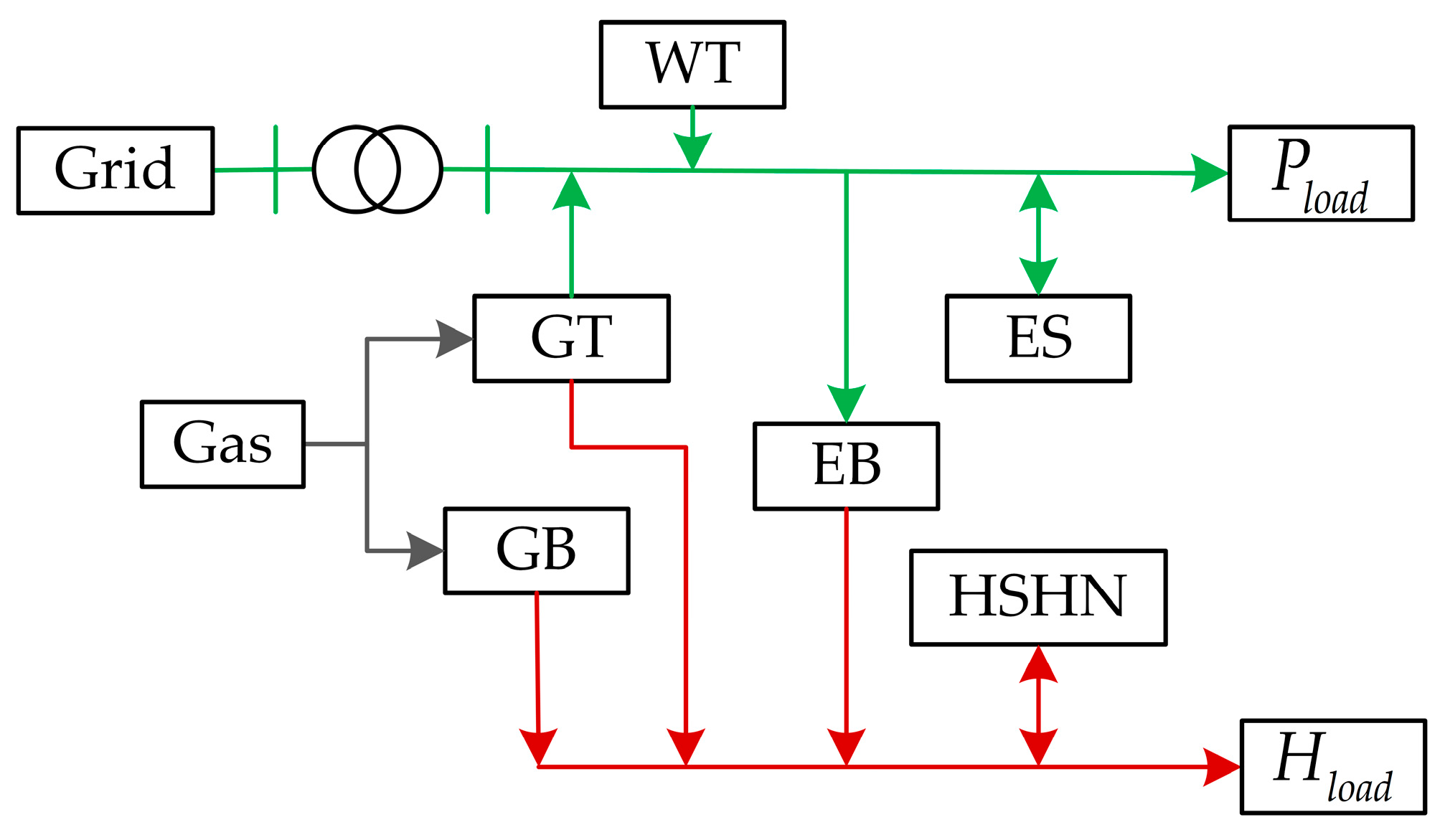
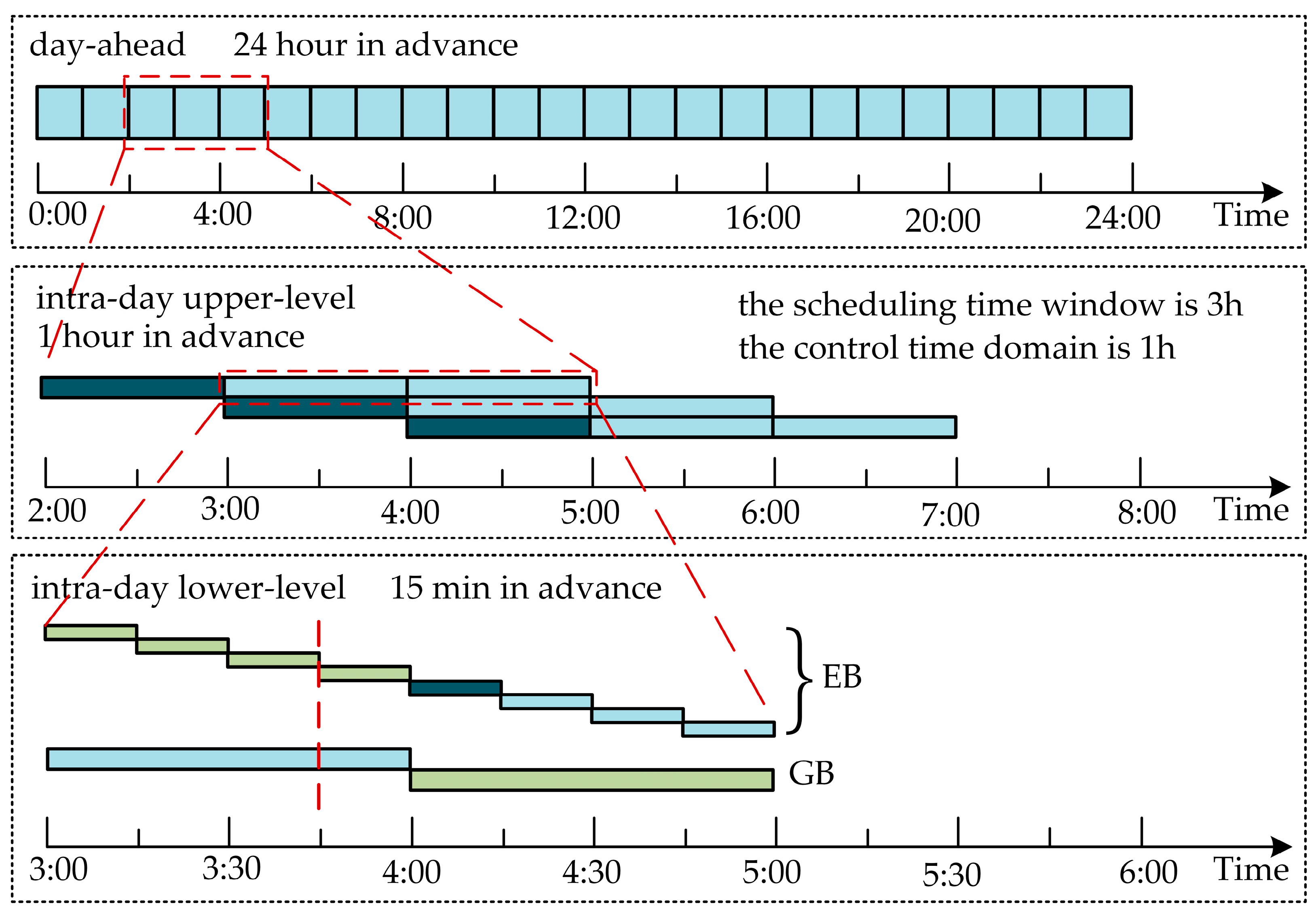


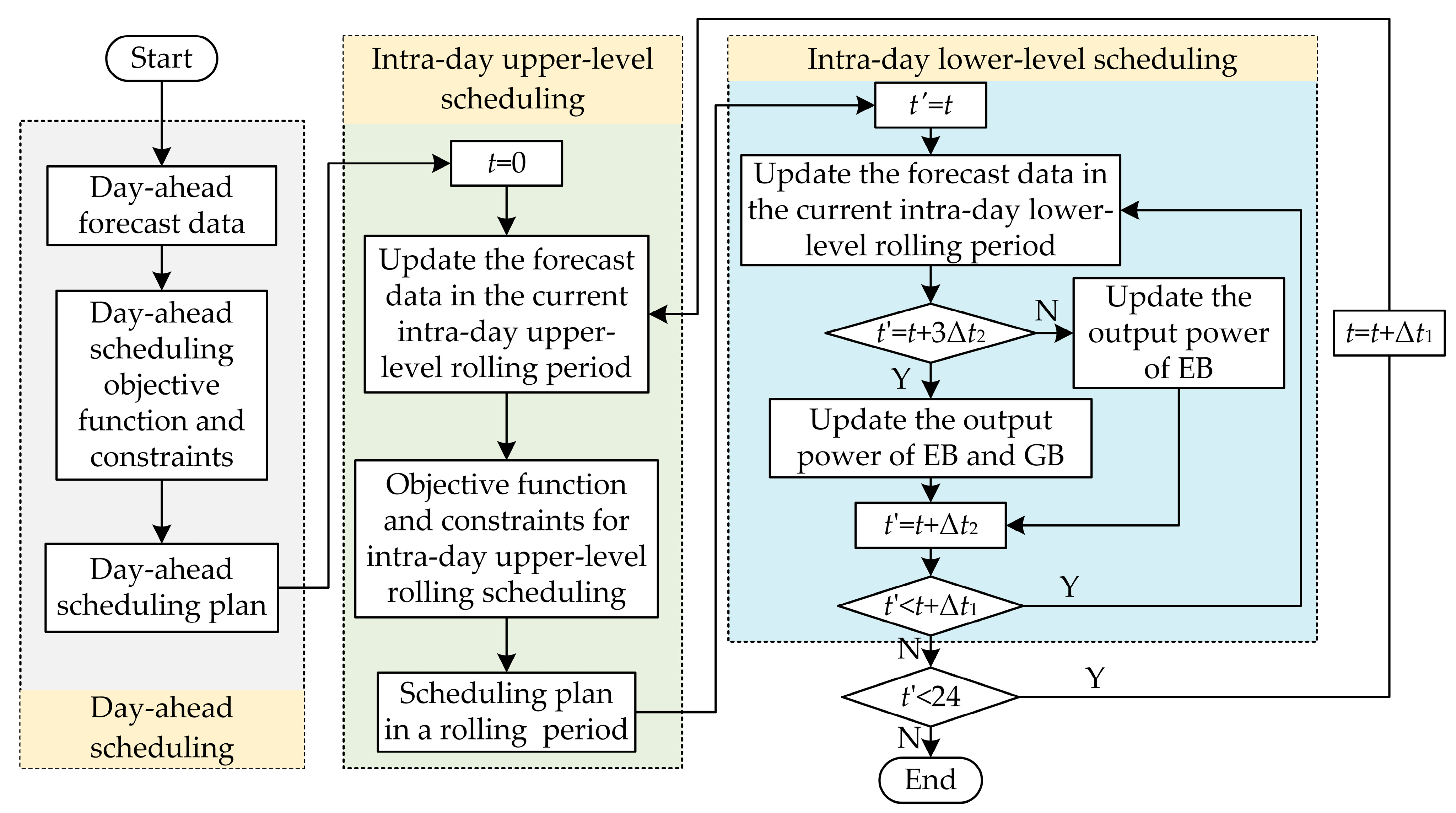
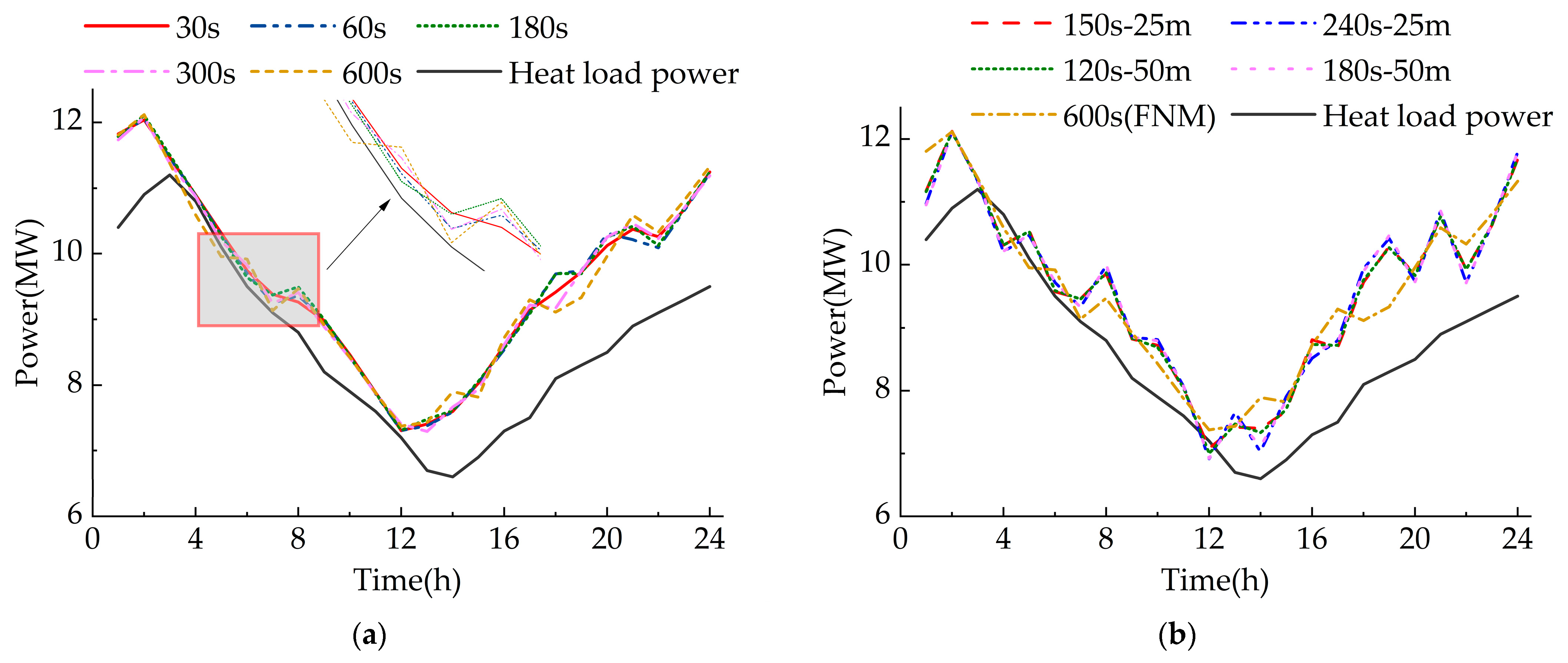

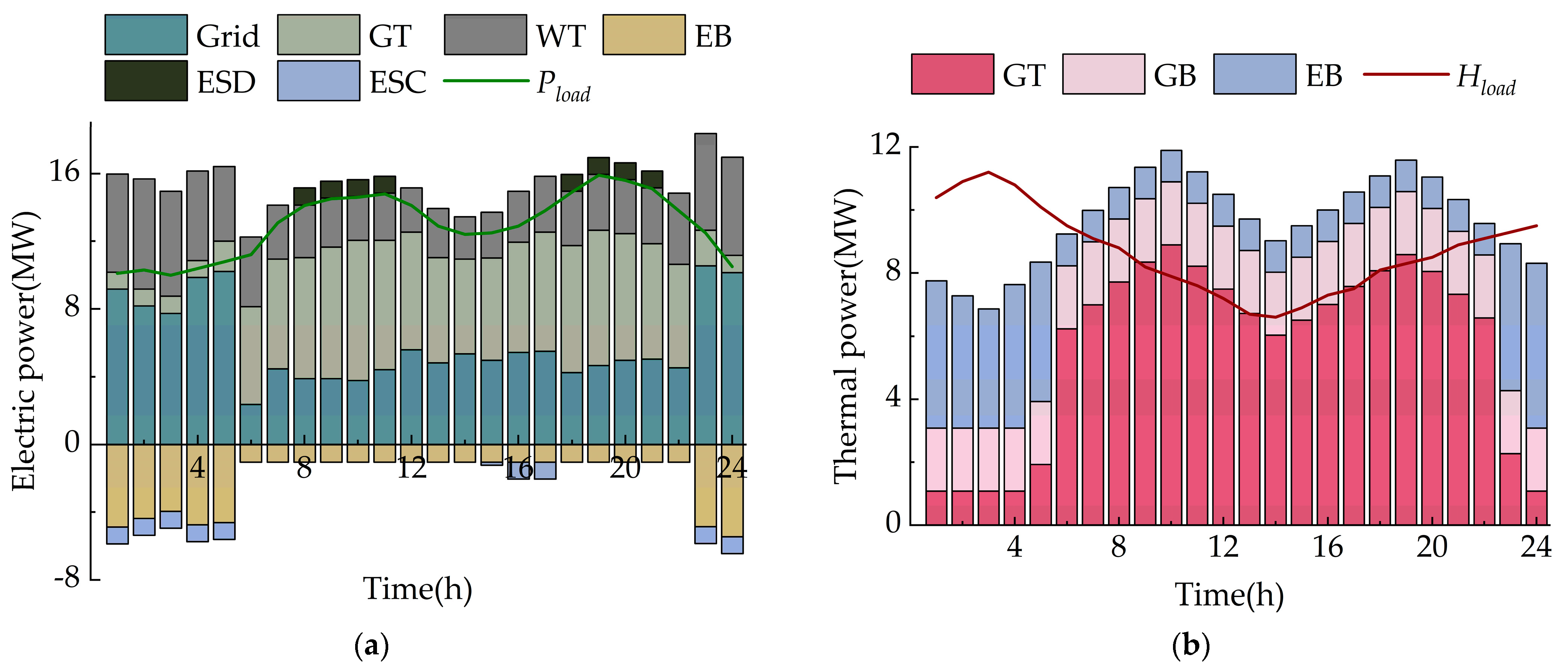
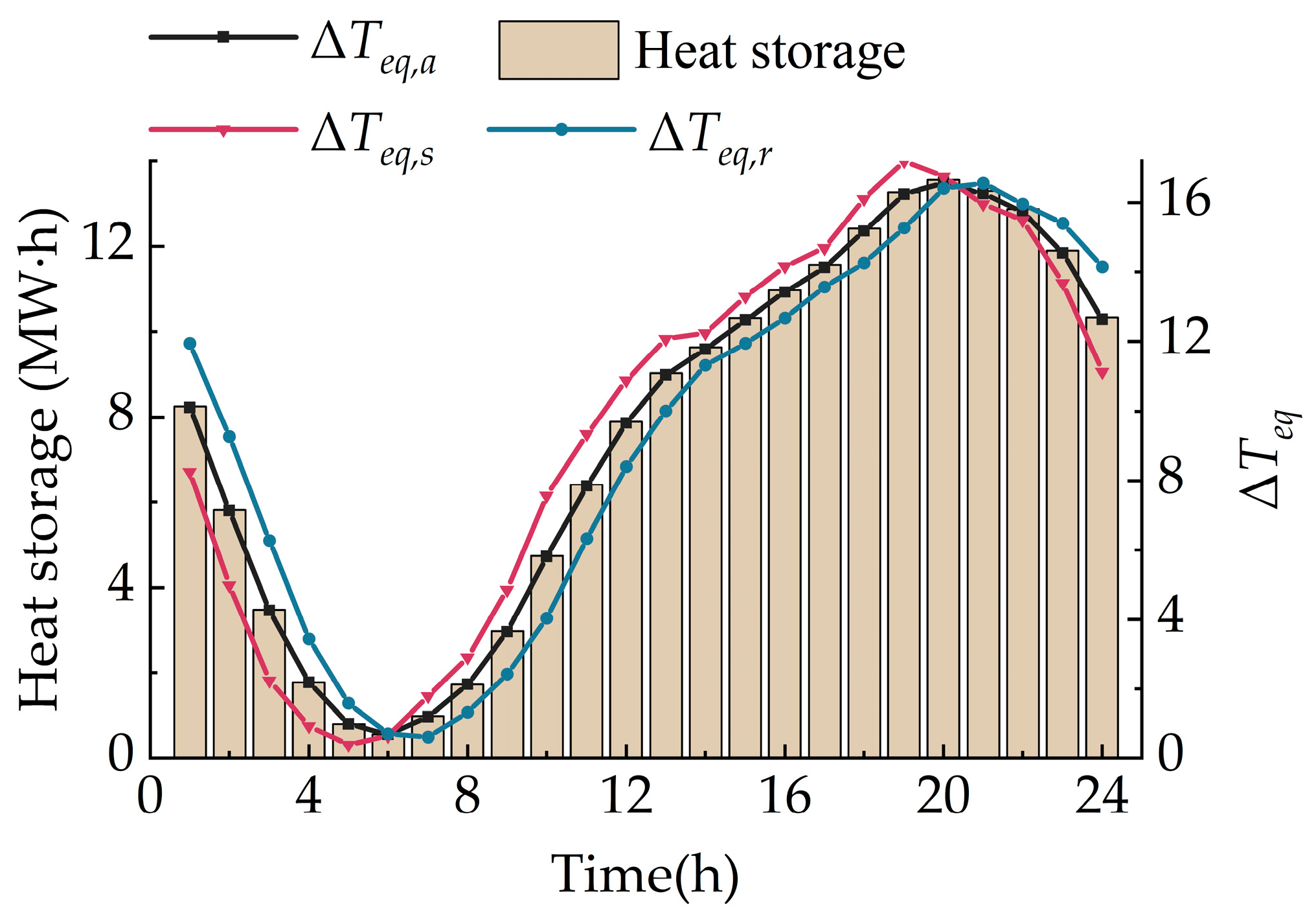
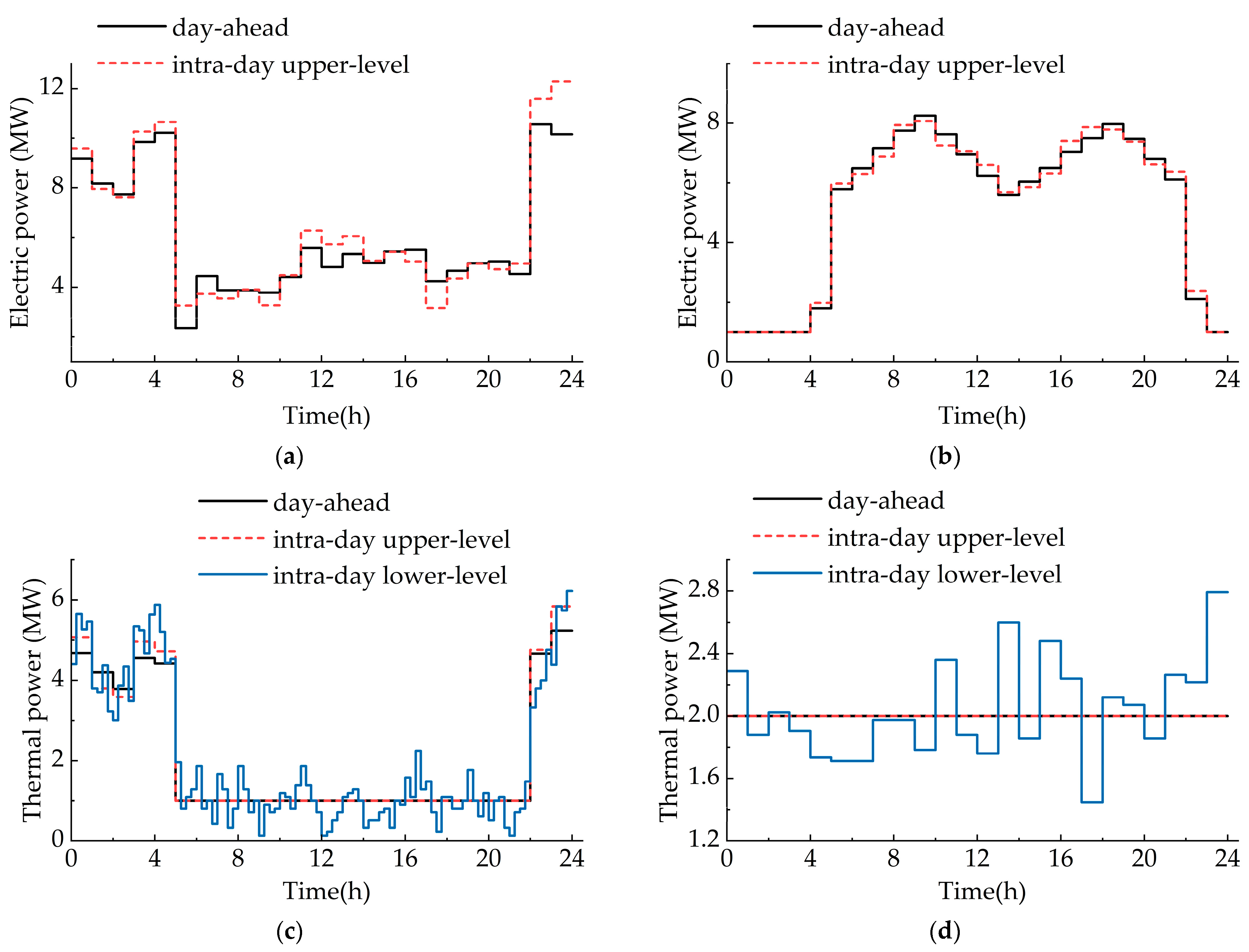

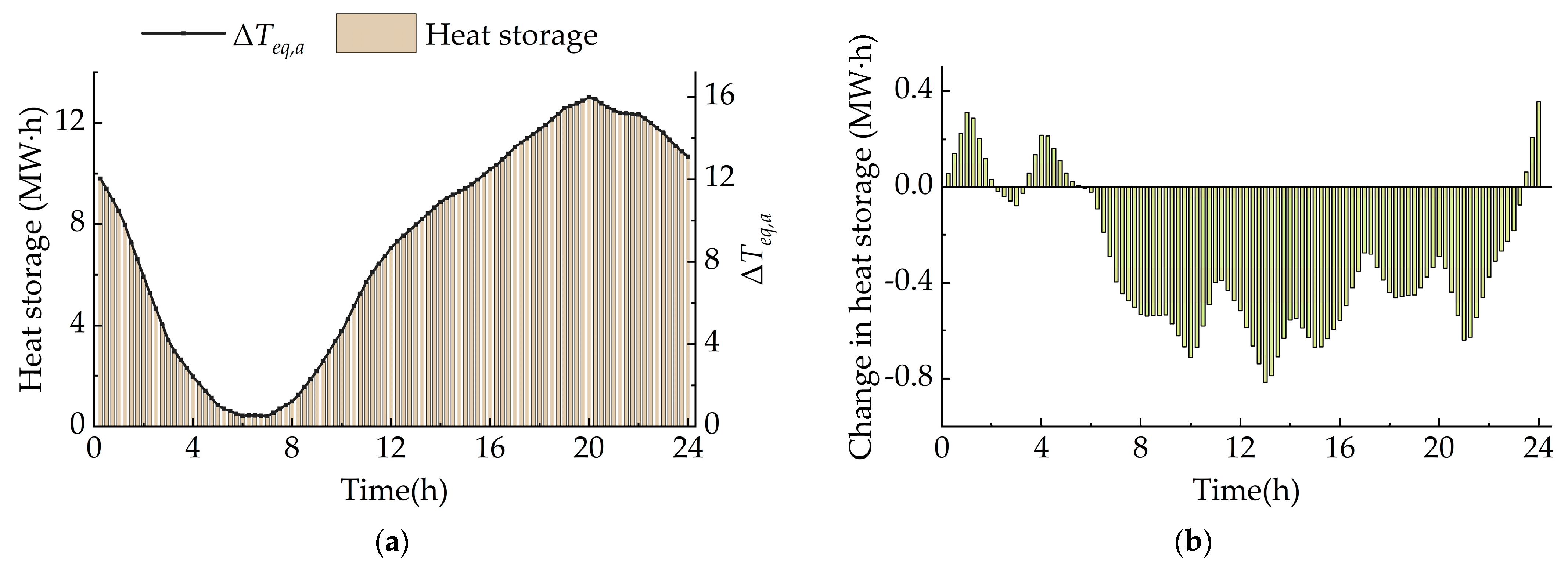

| Pipeline | L (m) | d (m) | m (kg/s) | Pipeline | L (m) | d (m) | m (kg/s) |
|---|---|---|---|---|---|---|---|
| 1–2 | 450 | 0.6 | 136 | 16–17 | 500 | 0.2 | 16 |
| 2–3 | 400 | 0.3 | 40 | 17–18 | 300 | 0.15 | 8 |
| 3–4 | 650 | 0.15 | 8 | 17–19 | 550 | 0.15 | 8 |
| 3–5 | 550 | 0.15 | 8 | 16–20 | 500 | 0.2 | 16 |
| 3–6 | 500 | 0.3 | 24 | 20–21 | 550 | 0.15 | 8 |
| 6–7 | 550 | 0.15 | 8 | 20–22 | 350 | 0.15 | 8 |
| 6–8 | 600 | 0.2 | 16 | 11–23 | 400 | 0.3 | 40 |
| 8–9 | 450 | 0.15 | 8 | 23–24 | 450 | 0.15 | 8 |
| 8–10 | 550 | 0.15 | 8 | 23–25 | 550 | 0.15 | 8 |
| 2–11 | 800 | 0.5 | 96 | 23–26 | 500 | 0.3 | 24 |
| 11–12 | 550 | 0.15 | 8 | 26–27 | 550 | 0.15 | 8 |
| 11–13 | 350 | 0.4 | 48 | 26–28 | 500 | 0.2 | 16 |
| 13–14 | 350 | 0.15 | 8 | 28–29 | 550 | 0.15 | 8 |
| 13–15 | 550 | 0.15 | 8 | 28–30 | 450 | 0.15 | 8 |
| 13–16 | 450 | 0.3 | 32 |
| Parameters | Values | Parameters | Values | Parameters | Values | Parameters | Values |
|---|---|---|---|---|---|---|---|
| (MW) | 1 | (MW) | 1 | ηeb | 0.96 | βgas (¥/Nm3) | 3.15 |
| (MW) | 15 | (MW) | 10 | (MW·h) | 7 | εgb | 0.1 |
| (MW/h) | −4 | (MW/h) | −3 | (MW) | 1 | εeb | 0.1 |
| (MW/h) | 4 | (MW/h) | 3 | (MW) | 1 | λ (W/(m·°C)) | 0.45 |
| 0.39 | ηgb | 0.9 | σes (%) | 0.5 | ρ (kg/m3) | 1000 | |
| 0.42 | (MW) | 0 | ηc | 0.95 | T0 (°C) | 0 | |
| qgas (kW·h/Nm3) | 9.78 | (MW) | 10 | ηd | 0.96 | cw (J/(kg·°C)) | 4200 |
| (°C) | 100 | (°C) | 80 | (°C) | 65 | (°C) | 60 |
| Fictitious Node Method | Implicit Upwind Method | ||
|---|---|---|---|
| δt2 (s) | Time (s) | δt1-δx (s-m) | Time (s) |
| 30 | 47.2 | 150-25 | 900.4 |
| 60 | 14.8 | 180-25 | 503.2 |
| 120 | 6.9 | 240-25 | 153.7 |
| 180 | 4.9 | 120-50 | 806.6 |
| 300 | 3.3 | 150-50 | 346.3 |
| 600 | 2.1 | 180-50 | 243.5 |
Disclaimer/Publisher’s Note: The statements, opinions and data contained in all publications are solely those of the individual author(s) and contributor(s) and not of MDPI and/or the editor(s). MDPI and/or the editor(s) disclaim responsibility for any injury to people or property resulting from any ideas, methods, instructions or products referred to in the content. |
© 2023 by the authors. Licensee MDPI, Basel, Switzerland. This article is an open access article distributed under the terms and conditions of the Creative Commons Attribution (CC BY) license (https://creativecommons.org/licenses/by/4.0/).
Share and Cite
Wang, J.; Zeng, A.; Wan, Y. Multi-Time-Scale Optimal Scheduling of Integrated Energy System Considering Transmission Delay and Heat Storage of Heating Network. Sustainability 2023, 15, 14260. https://doi.org/10.3390/su151914260
Wang J, Zeng A, Wan Y. Multi-Time-Scale Optimal Scheduling of Integrated Energy System Considering Transmission Delay and Heat Storage of Heating Network. Sustainability. 2023; 15(19):14260. https://doi.org/10.3390/su151914260
Chicago/Turabian StyleWang, Jiawei, Aidong Zeng, and Yaheng Wan. 2023. "Multi-Time-Scale Optimal Scheduling of Integrated Energy System Considering Transmission Delay and Heat Storage of Heating Network" Sustainability 15, no. 19: 14260. https://doi.org/10.3390/su151914260
APA StyleWang, J., Zeng, A., & Wan, Y. (2023). Multi-Time-Scale Optimal Scheduling of Integrated Energy System Considering Transmission Delay and Heat Storage of Heating Network. Sustainability, 15(19), 14260. https://doi.org/10.3390/su151914260







